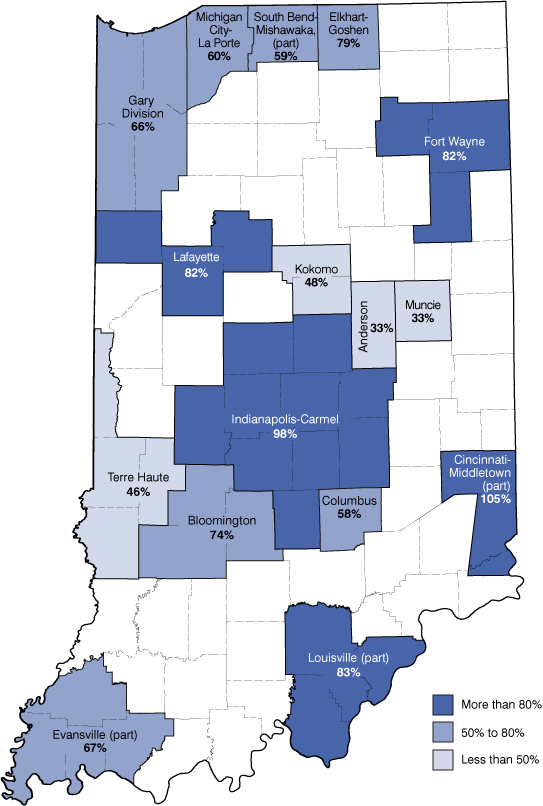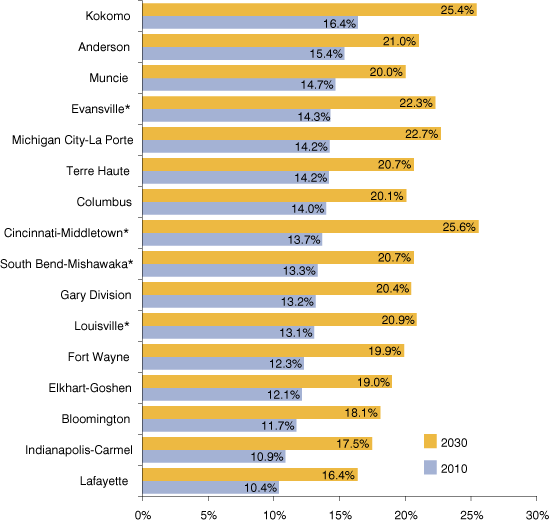Senior Citizens in Indiana Metros
New population projections from the Indiana Business Research Center highlight the impact aging baby boomers will have upon the demographic makeup of Indiana. Statewide, adults age 65 and older made up 13 percent of the population as of Census 2010. This number is projected to grow to 20 percent of the population by 2030. This article focuses on the growth in senior citizens across Indiana's metropolitan areas.
Figure 1 shows that five of Indiana's metros will see increases of more than 80 percent in the population age 65 and older in the next 20 years. In fact, spurred by a relatively strong net in-migration of older adults, the senior population in the Indiana portion of the Cincinnati-Middletown metro will more than double. The fast-growing Indianapolis-Carmel metro—which accounts for more than one-quarter of the state's total population—will see its senior population nearly double over the same period.
Figure 1: Percent Change in Population Age 65 and Older, 2010 to 2030

Note: The percent change for the non-metro portion of the state is 55 percent.
Source: Indiana Business Research Center
Meanwhile, only four metros will experience growth in seniors less than 50 percent, ranging from 32.5 percent in Anderson to 48 percent in Kokomo. However, it is worth noting that three of those will experience declines in total population and the fourth (Terre Haute) has total population growth of just a few hundred residents.
In other words, even though the senior population in Kokomo is expected to grow by one of the smaller percentages statewide, this age group will continue to hold a comparatively large share of Kokomo's total population. As of Census 2010, 16.4 percent of Kokomo's population was 65 or older—the largest share among metro areas. At the other end of the spectrum, Lafayette (with its large share of college students) had the lowest share at 10.4 percent.
Figure 2 shows that by 2030, Lafayette will reach 16.4 percent while more than a quarter of Kokomo's population will be made up of senior citizens. The Indiana portion of the Cincinnati-Middletown metro is expected to experience the most dramatic growth in seniors—shooting up by almost 12 percentage points—and will slightly exceed Kokomo's share.1
Figure 2: Percent of Population Age 65 and Older, 2010 and 2030

*Indiana portion only
Note: The share for the non-metro portion of the state is expected to grow from 15 percent in 2010 to 23.3 percent by 2030.
Source: Indiana Business Research Center
Beyond 2030
The entire baby boomer cohort will be of traditional retirement age by 2030. After that point, growth in the 65+ category is expected to level off somewhat. However, between 2030 and 2050, large increases are anticipated in the 85+ age group as those boomers continue to age (see Figure 3).2
Figure 3: Percent of Population Age 65 and Older, 2010 to 2050
Interactive graphic no longer available
Source: Indiana Business Research Center
Access more data and maps from the state's official population projections (available for counties, metros, regions and statewide) on STATS Indiana at www.stats.indiana.edu/topic/projections.asp.
Notes
- Two factors help explain the comparatively rapid aging in the Indiana portion of the Cincinnati-Middletown metro. First is the strong net in-migration of older adults mentioned earlier. Second, this region is unique among Indiana's metro areas (or metro parts) in that it consists of just three counties—Dearborn, Franklin and Ohio—that are on the periphery of the metro area and have relatively small populations. By themselves, these counties lack the large urban core that will tend to keep many metro areas relatively young. This area has already seen rapid aging. Between 2000 and 2010, Ohio County had Indiana's second-largest increase in median age of the population while Franklin and Dearborn counties ranked 13th and 21st, respectively.
- Note that the population projections do take into account increases in life expectancy over time, using rates based on prior projections from the Census Bureau.
Rachel Justis
Geodemographic Analyst, Indiana Business Research Center, Indiana University Kelley School of Business
Matt Kinghorn
Demographer, Indiana Business Research Center, Indiana University Kelley School of Business
